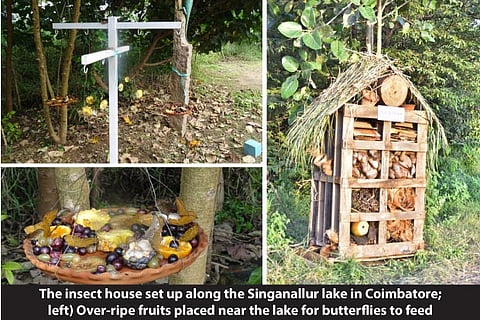

Coimbatore
Perhaps Coimbatore’s and probably Tamil Nadu’s first such insect house has been set up in an urban wetland, the Singanallur lake, in a joint initiative by the Coimbatore Corporation and volunteers of the Centre for Urban Biodiversity Conservation and Education (CUBE).
“Insects play a major role in food chain management and in maintaining proper ecological balance. However, their significance in maintaining a balanced environment is not understood by people. And with rising concrete houses, the insect population has come crashing and threatens to cause negative consequences on the vital food chain system in cities,” said S Varun, a volunteer of CUBE.
To increase insect diversity, the volunteers have set up a wooden insect house along the lake bunds. “The house has been stuffed with coconut fibre, bamboo and roofing tile (odu). Insects have already begun visiting their house. As our initiative, taken up on a pilot basis, has evoked positive response, we have decided to put up at least 20 such houses in the coming days,” he added.
These houses will provide shelter for all sorts of insects found in abundance in the lake area. Some insects help in pollination of food crops, while some are part of food chain and turn out to be a feed for birds flocking the lake and others take up decomposing organic matter, which is essential for maintaining soil fertility. The Singanallur lake already has rich bio-diversity with more than 150 species of butterfly, dragon fly and damselfly alone.
“We have also recorded more than 100 other insect species in the lake. It is home to a variety of grass hoppers, jewel beetle, leaf eating beetle, dung beetle, tortoise beetle, long horned beetle and ground beetle. There may be more than 400 species of insects and an extensive study is required to understand the complete profile of insects in the locality. Already different groups of research teams have taken up study in this regard. There is even a possibility to find some new species of insects in the lake,” said D Vasanthakumar, insect researcher from Zoological Survey of India.
The researcher said that increasing the population of insects in a locality will also attract more number of birds to the lake. The lake, declared as an urban biodiversity hotspot, has been visited by hundreds of students every week on nature trails. “So, our main objective is to create awareness among them on the importance of conserving these insects. As it has become difficult for insects to find a suitable habitat in residential areas, the students are encouraged to keep such insect houses in their neighbourhood to increase insect diversity. Even in apartments and larger housing communities, the gardens are spruced up with ornamental plants that do not serve any purpose for insects. Sensitising the youngsters may in-turn make them work towards developing an balanced environment,” said Varun.
Apart from insects, overripe fruits like grape, orange and pineapple were also placed in the lake bunds to attract butterflies. The butterflies do not live on nectar alone and feed on such fruit juice with sugary content too as they provide them with much needed minerals. Salt blocks were also placed in the lake bunds, he added.
Visit news.dtnext.in to explore our interactive epaper!
Download the DT Next app for more exciting features!
Click here for iOS
Click here for Android